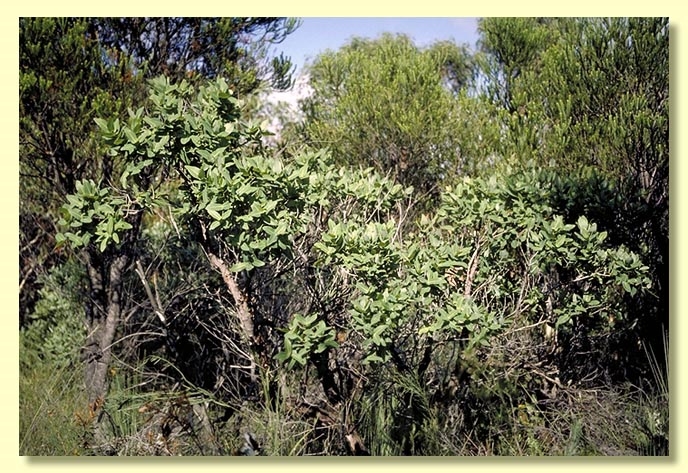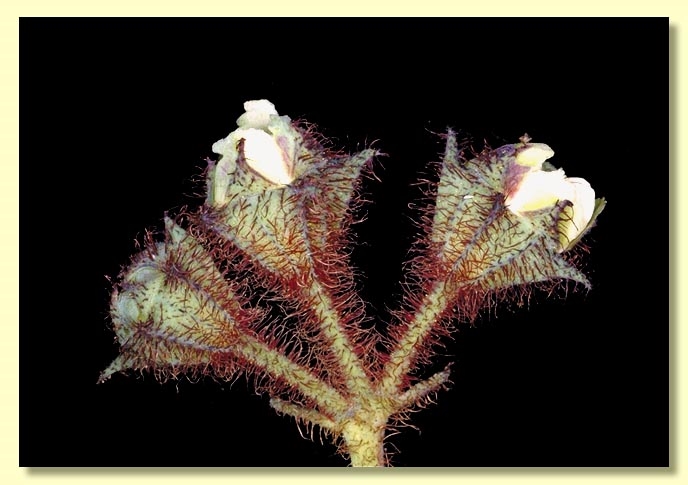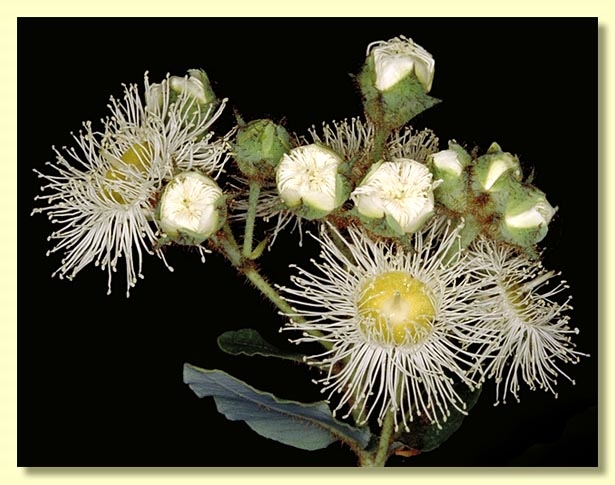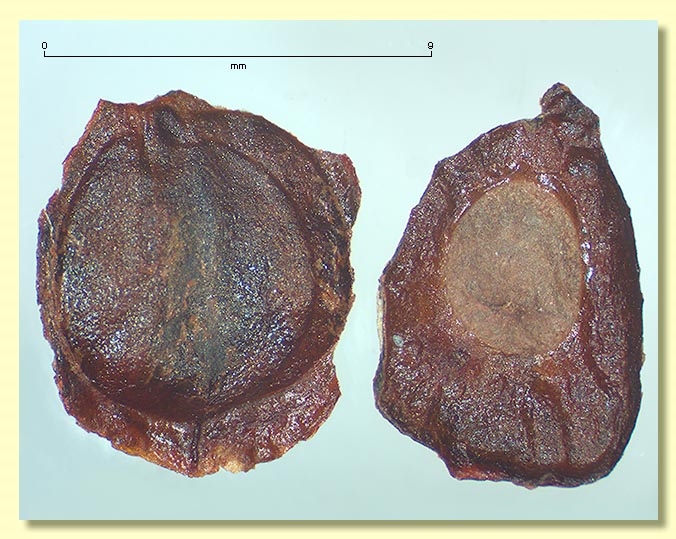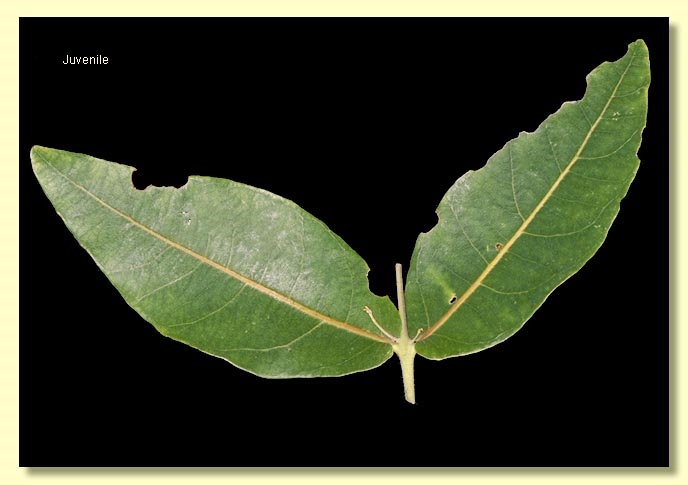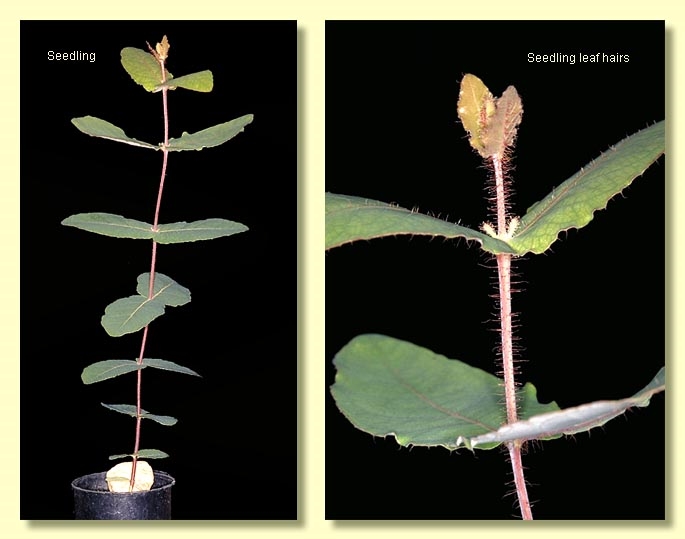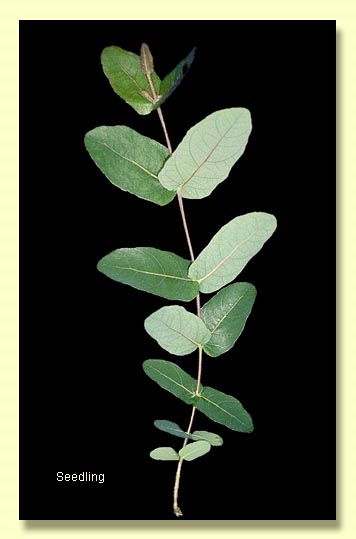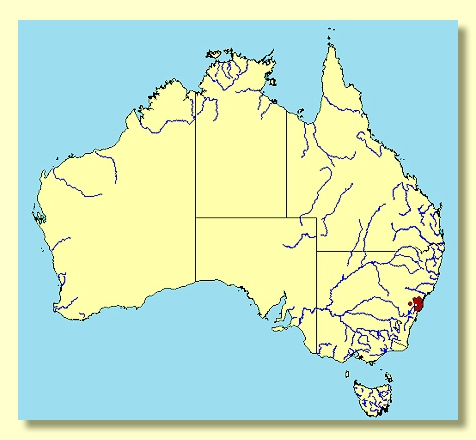Euclid - Online edition
Angophora hispida
Classification
Angophora
Nomenclature
Angophora hispida (Sm.) Blaxell, Kew Bull. 31: 272 (1976).
Metrosideros hispida Sm., Trans. Linn. Soc. London 3: 267 (1797); Eucalyptus hispida (Sm.) Brooker, Austral. Sys. Bot. 13: 136 (2000). T: Port Jackson, NSW, 1795, J.White s.n.; holo: LINN.
Angophora cordifolia Cav., Icon 4: 21, t. 338 (1797); Metrosideros cordifolia (Cav.) Pers., Syn Pl. 2: 25 (1806). T: ex Port Jackson, NSW, collector unknown; holo: MA.
Metrosideros hirsuta Andrews, Bot. Repos. 4, t. 281 (1803). T: t. 281 in H.C.Andrews, loc. cit.; lecto: the original plate, fide G.J.Leach, Telopea 2: 773 (1986).
Metrosideros anomala Vent., Jard. Malm. 5, t. 5 (1803). T: t. 5 in E. P.Ventenat, loc. cit.; lecto: the original plate, fide G.J.Leach, Telopea 2: 773 (1986).
Eucalyptus hirsuta Link, Enum. Hort. Berol. 2: 31 (1822). T: destroyed at B.
Metrosideros hispida Sm., Trans. Linn. Soc. London 3: 267 (1797); Eucalyptus hispida (Sm.) Brooker, Austral. Sys. Bot. 13: 136 (2000). T: Port Jackson, NSW, 1795, J.White s.n.; holo: LINN.
Angophora cordifolia Cav., Icon 4: 21, t. 338 (1797); Metrosideros cordifolia (Cav.) Pers., Syn Pl. 2: 25 (1806). T: ex Port Jackson, NSW, collector unknown; holo: MA.
Metrosideros hirsuta Andrews, Bot. Repos. 4, t. 281 (1803). T: t. 281 in H.C.Andrews, loc. cit.; lecto: the original plate, fide G.J.Leach, Telopea 2: 773 (1986).
Metrosideros anomala Vent., Jard. Malm. 5, t. 5 (1803). T: t. 5 in E. P.Ventenat, loc. cit.; lecto: the original plate, fide G.J.Leach, Telopea 2: 773 (1986).
Eucalyptus hirsuta Link, Enum. Hort. Berol. 2: 31 (1822). T: destroyed at B.
Description
Large shrub to small tree , 1.5–8 m tall. Forming a lignotuber.
Bark rough to the small branches, fibrous, grey to grey-brown. Oil glands not seen in the pith but expected to be found on young branchlets at the nodes.
Juvenile stem rounded in cross-section, pubescent; juvenile leaves opposite, sessile, ovate, 10–14 cm long, 4–6 cm wide, base amplexicaul, margin entire, apex acute, green, pubescent or glabrous.
Adult leaves opposite, sessile (or rarely petiolate), petioles 0–0.4 cm long; blade ovate to elliptical to cordate, 5–11.5 cm long, 2–6 cm wide, usually thick and rigid, undulate to flat, base amplexicaul, margin entire or occasionally crenulate, apex usually rounded, sometimes acute, discolorous, slightly glossy, green to olive green to dull grey-green, penniveined, very densely reticulate, intramarginal vein present or absent, oil glands obscure or apparently absent, lamina glabrous to moderately pubescent.
Inflorescence terminal compound, peduncles 1.5–7 cm long, buds 3 or 7 per umbel, pedicellate (pedicels 0.8–3.2 cm long). Mature buds globular (0.9–1.3 cm wide, 0.7–1.3 cm wide), hypanthium pubescent, longitudinally ribbed, petals white with a green keel, stamens inflexed, anthers oblong, versatile, dehiscing by longitudinal slits (non-confluent), style long, stigma blunt, mop-like, locules 3 or 4, the placentae each with 5 vertical ovule rows. Flowers white to creamy white, or yellow to lemon, or pink (rarely).
Fruit pedicellate (pedicels 0.8–3.6 cm long), cup-shaped, 1.5–2.6 cm long, 1.3–2 cm wide, longitudinally ribbed, disc level or descending, valves 3 or 4, enclosed.
Seeds reddish brown to brown, 8–10 mm long, flattened-ellipsoidal, dorsal surface smooth, hilum ventral.
Cultivated seedlings (measured at ca node 10): cotyledons reniform to orbicular; stems rounded in cross-section, scabrid with bristle-glands and hairs; leaves opposite, sessile, cordate to oblong, 5–9(10) cm long, 2.5–5(5.5) cm wide, amplexicaul, margin entire or irregular, apex pointed, discolorous, green, scabrid.
Bark rough to the small branches, fibrous, grey to grey-brown. Oil glands not seen in the pith but expected to be found on young branchlets at the nodes.
Juvenile stem rounded in cross-section, pubescent; juvenile leaves opposite, sessile, ovate, 10–14 cm long, 4–6 cm wide, base amplexicaul, margin entire, apex acute, green, pubescent or glabrous.
Adult leaves opposite, sessile (or rarely petiolate), petioles 0–0.4 cm long; blade ovate to elliptical to cordate, 5–11.5 cm long, 2–6 cm wide, usually thick and rigid, undulate to flat, base amplexicaul, margin entire or occasionally crenulate, apex usually rounded, sometimes acute, discolorous, slightly glossy, green to olive green to dull grey-green, penniveined, very densely reticulate, intramarginal vein present or absent, oil glands obscure or apparently absent, lamina glabrous to moderately pubescent.
Inflorescence terminal compound, peduncles 1.5–7 cm long, buds 3 or 7 per umbel, pedicellate (pedicels 0.8–3.2 cm long). Mature buds globular (0.9–1.3 cm wide, 0.7–1.3 cm wide), hypanthium pubescent, longitudinally ribbed, petals white with a green keel, stamens inflexed, anthers oblong, versatile, dehiscing by longitudinal slits (non-confluent), style long, stigma blunt, mop-like, locules 3 or 4, the placentae each with 5 vertical ovule rows. Flowers white to creamy white, or yellow to lemon, or pink (rarely).
Fruit pedicellate (pedicels 0.8–3.6 cm long), cup-shaped, 1.5–2.6 cm long, 1.3–2 cm wide, longitudinally ribbed, disc level or descending, valves 3 or 4, enclosed.
Seeds reddish brown to brown, 8–10 mm long, flattened-ellipsoidal, dorsal surface smooth, hilum ventral.
Cultivated seedlings (measured at ca node 10): cotyledons reniform to orbicular; stems rounded in cross-section, scabrid with bristle-glands and hairs; leaves opposite, sessile, cordate to oblong, 5–9(10) cm long, 2.5–5(5.5) cm wide, amplexicaul, margin entire or irregular, apex pointed, discolorous, green, scabrid.
Flowering Time
Flowering has been recorded in January, February, May, September, November and December.
Notes
A. hispida belongs in the group of three Angophora species which is diagnosed by the rough bark and the ± sessile juvenile leaves persisting in the crown of the adult plant. The other members of this group are A. subvelutina and A. robur.
A mallee or small tree confined to the Central Coast of New South Wales, ranging from just south of Sydney north to the Gosford area. A. subvelutina, of the same group, differs by being a taller tree with soft leaves (usually thick and rigid in A. hispida) and by having smaller fruit (normally 0.8–1.1 cm long and 0.6–1.1 cm wide in A. subvelutina, but 1.2–1.7 cm long and 1.2–1.6 cm wide in A. hispida). A. robur, also of the same group, has a similar habit, buds, fruit and the thick, rigid leaves like A. hispida but has slightly larger leaves usually with pointed tips (usually obtuse in A. hispida).
MORE ABOUT ANGOPHORA
A mallee or small tree confined to the Central Coast of New South Wales, ranging from just south of Sydney north to the Gosford area. A. subvelutina, of the same group, differs by being a taller tree with soft leaves (usually thick and rigid in A. hispida) and by having smaller fruit (normally 0.8–1.1 cm long and 0.6–1.1 cm wide in A. subvelutina, but 1.2–1.7 cm long and 1.2–1.6 cm wide in A. hispida). A. robur, also of the same group, has a similar habit, buds, fruit and the thick, rigid leaves like A. hispida but has slightly larger leaves usually with pointed tips (usually obtuse in A. hispida).
MORE ABOUT ANGOPHORA
Origin of Name
Angophora hispida: Latin hispidus, rough to the touch, of the leaves.
Copyright © CANBR 2020, all rights reserved.

Web edition hosted at https://apps.lucidcentral.org/euclid
